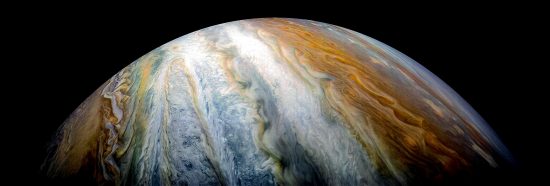May 9, 2018
Electric fields are common in the Solar System
The Juno spacecraft is orbiting Jupiter after arriving in July of 2016. Juno is part of the New Frontiers Program and will remain in orbit for 2 years, before it will be burned-up in Jupiter’s clouds. Juno is studying Jupiter’s atmosphere, looking for water and analyzing its composition. Juno is also looking at the gas giant’s magnetic and gravitational fields.
One of Juno’s most important discoveries is that Jupiter’s atmospheric bands are deeper than previously thought. Those cloud bands cannot be penetrated by visible light. However, microwave detectors allow Juno to see as deep as mission coordinators want to look. The satellite is searching a little over 400 kilometers below the surface of the cloud tops, and, as mentioned in a previous Picture of the Day, the slight differences in layers suggests that they are “dynamic and constantly evolving.”
During the same flyby, while observing Jupiter’s aurorae, Juno’s electromagnetic data began to diverge markedly from what NASA team members predicted: it was much stronger. Jupiter’s magnetic field is far more complex than previously assumed. It is a flow of electric charge that causes aurorae at the poles. Since Jupiter is obviously electrical, the basic physics of charged objects in motion generating electromagnetism should be the focus.
Jupiter is the largest of all the planets. At 142,984 kilometers in diameter at its equator, it is so large that all the other planets could fit within its volume. Jupiter rotates so fast that a day lasts only 9.925 hours. As written in previous articles, a spinning charged body generates a dipolar magnetic field.
Jupiter’s magnetosphere is so powerful that it extends for nearly 650 million kilometers, reaching beyond Saturn’s orbit. Zones of extreme radiation, similar to the Van Allen radiation belts, surround the planet, except that the radiation from Jupiter would be instantly fatal to any organism without heavy lead shielding.
The most energetic of the trapped electrons in its magnetosphere emit radio frequencies. In 1955 that radiation led to the discovery that Jupiter had a magnetic field. It should be noted, however, that the maverick scientist, Immanuel Velikovsky, predicted that field in October of 1953.
When the Galileo spacecraft entered orbit around Jupiter, it found electrical power greater than 2 trillion watts dissipated between Jupiter and its enigmatic moon, Io. Electric current travels along Jupiter’s magnetic field, creating intense aurorae at the poles. An electrical interaction between Jupiter and its moons means that they are charged bodies and not electrically neutral. Jupiter exists in a dynamic electrical relationship to the Sun, and it is now known that charged particles from the Sun and not “electric dynamos” power the planets. As mentioned, rotating charged bodies produce dipolar electromagnetic fields. No matter if they are gas giants or rocky planets, the basic physics of charged objects in motion generating electromagnetism is not debated.
Whenever there are regions of opposite charge, double layers form and electric fields develop. An electric field, no matter how weak, accelerates charged particles. This could explain why the atmospheric bands are so deep, Jupiter’s electric field accelerates plasmas at different rates.
Data from Juno supports Electric Universe ideas about Jupiter and other charged celestial objects.
Stephen Smith













